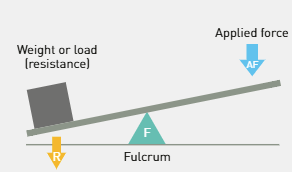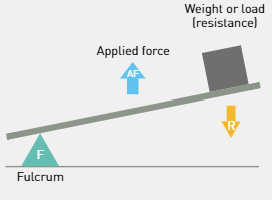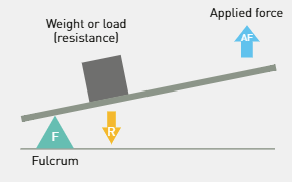Projectile motion
a type of force that is generated inside the body (e.g. muscles inside the body contracting and relaxing to pull on tendons and joints to generate movement)
Internal force
any movement that happens along a straight line
linear motion
What is considered the optimal angle of release (can vary among sports)?
45 degrees
The ability of an individual to control the influence of internal and external factors on their performance of a motor skill is called?
stability
What class of lever is this?

first-class lever
a type of force that is generated outside the body or through an interaction with the body and the external environment (e.g. gravity, resistance from the air or water, contact with other objects or people)
External force
any movement that happens along a curved line
curvilinear motion
2-part question:
What is the name of this law and which number law is this?
‘A body continues in a state of rest or uniform velocity unless acted upon by an external force.’
Newtons first law of motion - Inertia
a term used to describe the ability of a person or thing to control their state of equilibrium (i.e. distribute their weight evenly in order to remain upright and not fall over) is called?
Balance
What class of lever is this?

third-class lever
What are the two main types of external forces
contact forces
non-contact forces
any movement that happens along a circular line around an axis (i.e. central point)
Angular motion
In addition to the effects of external forces, what three factors influence the trajectory of every projectile?
angle of release
height of release
speed of release
What are the two types of balance?
static balance
dynamic balance
What class of lever is this?
second-class lever
a term used to describe the sequential combination of forces produced by different parts of the human body acting together to maximise force production
Summation of forces
any movement that combines linear motion and angular motion
general motion
2-part question:
What is the name of this law and which number law is this?
‘For every action there is an equal and opposite reaction.'
Newton's third law of motion - reaction
The ability of a person or thing to maintain balance and stability is dependent on a number of factors. These include
centre of gravity
line of gravity
mass
What are the three main parts to a lever?
Fulcrum
load/resistance
Applied force (effort)
Identify one type of contact force and one type of non-contact force
Non-contact:
gravity
Contact:
ground reaction force
joint reaction force
friction force
drag force
inertial force
elastic force
identify the five most common concepts used to describe and measure different types of motion.
Speed
Velocity
Acceleration
Displacement
Distance
2-part question:
What is the name of this law and which number law is this?
‘When a force acts on an object, the acceleration experienced by the object is proportional to the size of the force and takes place in the direction in which the force acts.’
Newton's second law of motion - acceleration
what are the 5 different ways that balance and stability can be maximised?
• increasing the base of support as required
• ensuring the line of gravity falls within the base of support
• shifting the line of gravity towards the oncoming force
• lowering the centre of gravity
• increasing mass.
Provide one example of each lever in the human body
First class lever - nodding the head
Second-class lever - calf raise
Third-class lever - bicep curl